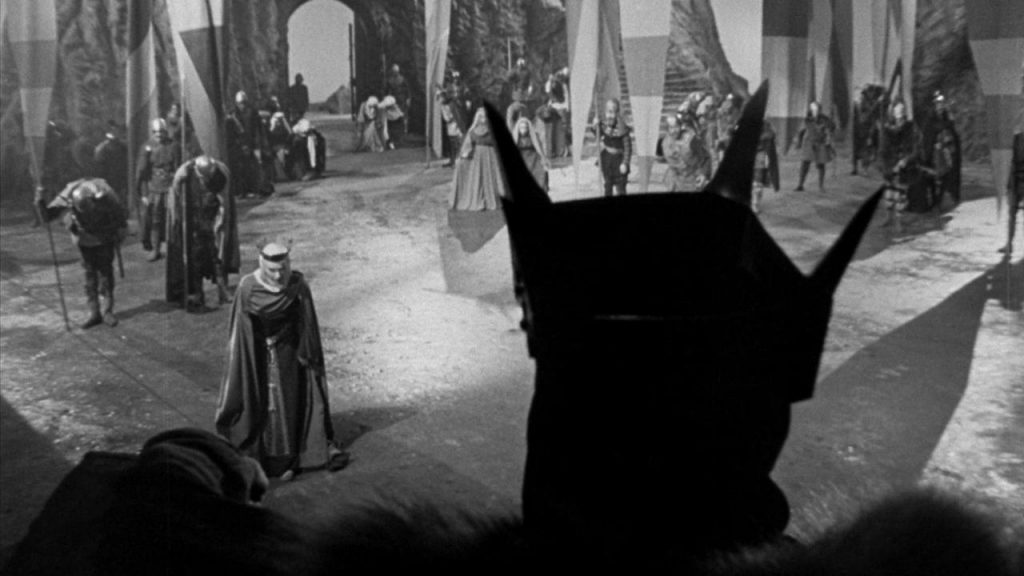“My purpose in making Macbeth was not to make a great film – and this is unusual, because I think that every film director, even when he is making nonsense, should have as his purpose the making of a great film. I thought I was making what might be a good film, and what, if the 23-day day shoot schedule came off, might encourage other filmmakers to tackle difficult subjects at greater speed. Unfortunately, not one critic in any part of the world chose to compliment me on the speed. They thought it was a scandal that it should only take 23 days. Of course, they were right, but I could not write to every one of them and explain that no one would give me any money for a further day’s shooting…However, I am not ashamed of the limitations of the picture.”-Orson Welles in conversation with Peter Cowie, The Cinema Of Orson Welles, 1960

In 1936 Orson Welles put on one of the most audacious productions of William Shakespeare’s tragedy Macbeth for the Federal Theatre Project, which has hence been known as the Voodoo Macbeth. Welles transported the tragedy from eleventh century Scotland to Haiti. Welles expanded the part of the witches, enriching the voodoo element of his production. Welles’ production of Macbeth is also notable for its all black cast, which at the time had never been done, let alone with one of the classics of the stage. Twelve years later, Welles would again adapt the Bard’s tragedy, this time for film at Republic Pictures.
Welles’ 1948 film adaptation barrows heavily from the European cinema, constructing an expressionist tableau that conjures similarities to the Gothic horror films of Universal Studios. For his film, Welles cast himself as the ill-fated Macbeth, Jeanette Nolan as Lady Macbeth, Dan O’Herlihy as Macduff, Erskine Sanford as Duncan, Roddy McDowall as Malcolm, and to play a character invented by Welles, Holy Father, Alan Napier. The character of Holy Father enables the film to move at a pace customary with the film’s mandatory running time and limited budget ($700,000.00). The character is a sort of amalgamation of characters who would not be able to have been adequately developed under these conditions.
Utilizing in-camera effects that were the hallmarks of F.W. Murnau’s work in the twenties largely represents the depiction of Macbeth’s psychological deterioration. In the scene where Banquo’s ghost appears at a banquet Welles recreates the shadow effect from Murnau’s Nosferatu (1922). The camera pans from Macbeth in close-up, tracking along his figure to his hand held out and pointing toward Banquo. The camera move continues, tracking along the elongated shadow cast by Macbeth’s hand pointing. Similarly, in a scene where Macbeth first adorns his crown he turns to face a distorted reflection of himself in a mirror. This brief moment recreates a scene from Murnau’s The Last Laugh (1924).
Welles’ use of the set, built entirely on a gigantic soundstage, also helps to recall Murnau’s similar use of Gothic style sets in his version of Faust (1926). The castle and the outlying territories are built from ragged raw stone, perpetually damp and cavernous. The unfinished, unrefined appearance of the film’s locations gives each frame a feeling of isolation, brutality and foreboding. Likewise, the set is lit to resemble either dusk or night, becoming a location of ongoing darkness. The effects mentioned above all correlate to represent not just the mood of Macbeth, but Macbeth’s own internal struggles and fears.
To pursue his total psychological representation of Macbeth, Welles looks beyond the expressionist films of Murnau to the Soviet Cinema, specifically Sergei Eisenstein’s Ivan The Terrible Part 1(1944). Eisenstein’s use of moving camera and meticulous staging become pivotal to Welles’ Macbeth. Eisenstein obsessively foregrounds Tsar Ivan in frame, filling out the depth of the shot with a character centered in the middle of the frame behind Ivan, and a third character at the top of frame. With Ivan being the only character in close-up, the audience is reminded that the context of the film’s action exists only in regards to Ivan. Welles adopts this strategy whole-heartedly, imbuing his film with the same violent tension and paranoia that defined Ivan The Terrible Part 1. Some of Welles’ stranger framing choices in which a medium shot becomes a close-up because the second subject in frame is slightly cropped out is a direct result of the influence of Eisenstein’s earlier film Bezhin Meadow (1937).
Each component of Welles’ visual strategy in Macbeth is not entirely original; but redressed and realigned to suit Welles’ intentions this visual strategy becomes an amalgamation of the most innovative cinematic tactics of the time. That Welles never allows one component to clash with another or jettison the audience from their suspension of disbelief is a feat unto itself. In many ways, the styles of Murnau and Eisenstein could easily contradict one another, but Welles manages them with a seamless fluidity, tying them completely to the action of Macbeth.
